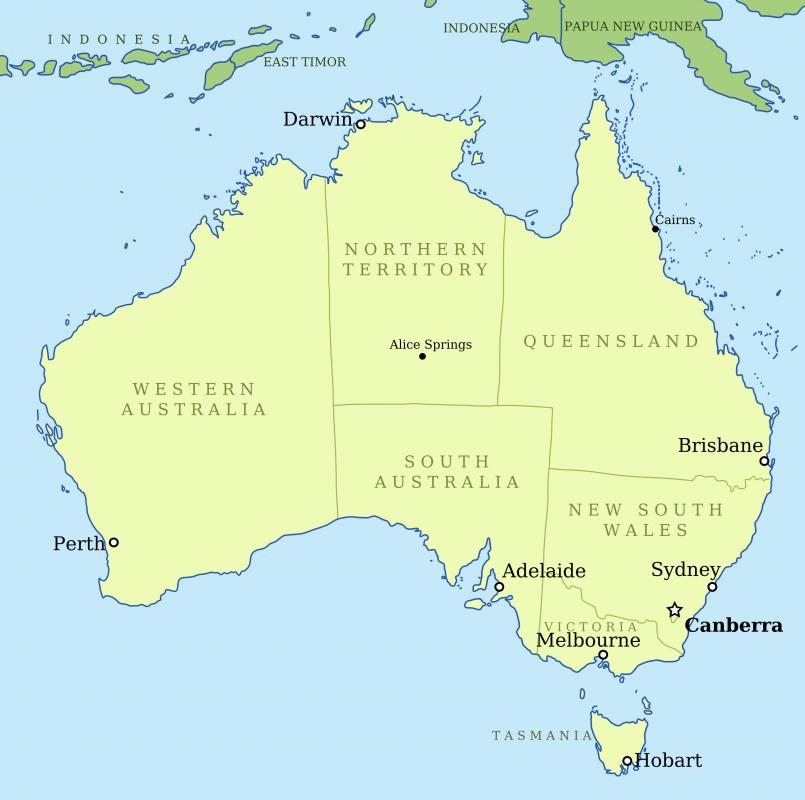At AllThingsNature, we're committed to delivering accurate, trustworthy information. Our expert-authored content is rigorously fact-checked and sourced from credible authorities. Discover how we uphold the highest standards in providing you with reliable knowledge.
What are Fiddler Crabs?
Fiddler crabs are a small type of eight-legged crab or crustacean that belongs to the genus, Uca, the order, Decapoda, and the family Ocypodidae. There are about 100 different species of fiddler crabs and approximately 20 of these are found in Australia. It’s very easy to tell the difference between a male and female fiddler crab as the male has one claw that is much larger than his other claw.
The larger claw in male fiddler crabs may be the left or the right. The male crab waves it to attract females for mating and also to challenge males to fight. Fighting between males is not usually very aggressive. Female fiddler crabs that are ready to mate are the ones that choose male crabs to mate with, walking by many claw-waving males before selecting one for mating. The egg-carrying female takes over the male fiddler crab's sand burrow home and he must often fight other males for a new home.

The batch of eggs that the female fiddler crab carries is called a sponge. The tiny baby crabs hatch into the water when they are larvae, looking nothing at all like developed crabs. There are thousands of babies in a sponge and many of them get eaten by predators after hatching. The ones that survive eat plankton. Fiddler crabs usually live for one year or one and a half years at most.

Fiddler crabs experience growth through molting, or absorbing their old shells and growing new ones. Most fiddler crabs molt at least once a year. A fiddler crab is likely to live in a group of thousands of others, with each crab having a separate sand burrow home. Fiddler crabs are said to have the ability to sense the odor of their own species.
Some species of fiddler crabs live in mud, while others can survive only in sand. A few species live in rocky areas. A fiddler crab breathes air, but must always stay near water as the gills must be wet at all times. Fiddler crabs use their small claws to gather food and since males have only one feeder claw, they take longer at this than females. The fiddler crab ingests food particles from bacteria, rotting plants and algae by using his or her mouth as a scraper.
Frequently Asked Questions
What are fiddler crabs and where can they be found?
Fiddler crabs are small, semi-terrestrial crabs known for their distinctive sexually dimorphic claws; the males have one oversized claw. They inhabit mangroves, salt marshes, and sandy or muddy beaches of estuaries and lagoons. These crabs are found along coastal regions worldwide, from the East Coast of the United States to the West Pacific islands.
Why do male fiddler crabs have one large claw?
The male fiddler crab's large claw serves multiple purposes: it is a display feature used to attract females and deter rivals. During mating rituals, males wave their oversized claws to impress potential mates. The claw also functions as a weapon in territorial disputes with other males, according to behavioral studies on crustaceans.
What do fiddler crabs eat?
Fiddler crabs are omnivores, feeding on a variety of organic matter. Their diet includes algae, detritus, and microorganisms which they sift from the sand or mud using their small feeding claws. This foraging behavior plays a crucial role in the aeration and nutrient cycling of their coastal habitats.
How do fiddler crabs communicate with each other?
Fiddler crabs communicate primarily through a series of visual signals and gestures, such as claw waving and body movements. These displays are essential for courtship, territorial defense, and identifying individuals. Research indicates that their communication can be quite complex, involving sequences of movements that convey specific messages.
What is the lifespan of a fiddler crab, and how do they reproduce?
Fiddler crabs typically live for about two years. Reproduction involves a courtship dance by the male, waving his large claw to attract females. After mating, females carry the eggs under their abdomen until they hatch, releasing the larvae into the ocean. The larvae go through several planktonic stages before settling and growing into adult crabs.
Are fiddler crabs important to the ecosystem?
Yes, fiddler crabs play a vital role in their ecosystems. Their burrowing and feeding activities aerate the soil, promoting nutrient exchange and aiding in the decomposition process. This activity benefits other organisms and contributes to the overall health of coastal ecosystems. They are also a food source for a variety of predators, linking different trophic levels.
AS FEATURED ON:
AS FEATURED ON:












Discuss this Article
Post your comments